Intel Core 2 Duo E6300 & E6400: Tremendous Value Through Overclocking
by Anand Lal Shimpi on July 26, 2006 8:17 AM EST- Posted in
- CPUs
Application Performance using SYSMark 2004 SE
We'll kick off our look at general application performance with SYSMark 2004 SE and as always, we'll look at the overall score as well as the scores in each of the two suites - Internet Content Creation and Office productivity.
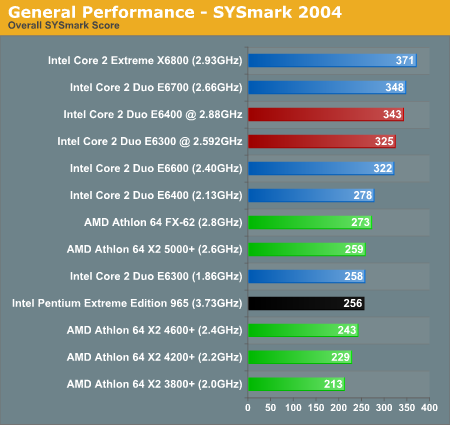
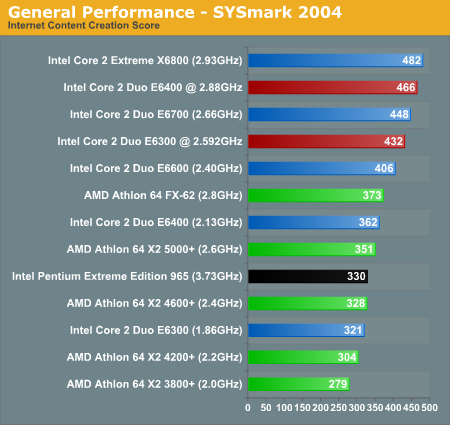
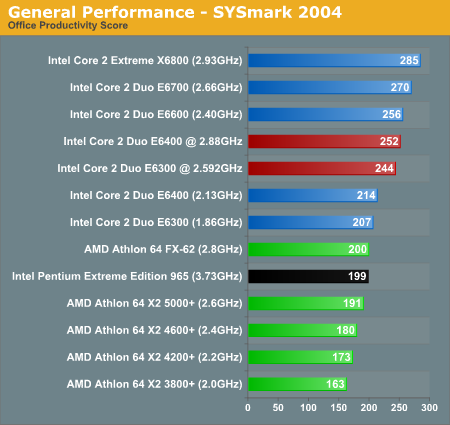
The applications tested by SYSmark 2004 cover the vast majority of the modern computing spectrum. Everything from multimedia to office to multitasking performance is included, and while not every application will show a substantial performance increase with a faster processor, the overall performance spread among the tested CPUs is almost 75%. If you routinely do a lot of computationally intensive work on your system (surfing the web and writing email generally don't count), there's no question that you will see a substantial difference between the fastest and slowest systems we're testing.
Our first look at the E6300/E6400 with overclocking generates some interesting results. There has been speculation that one of the reasons Core 2 Duo chips perform so well is that they have so much L2 cache. Dropping from 4 MB to 2 MB of cache does hurt performance a bit, but with a little bit of overclocking both of our budget Core 2 Duo chips perform very well. The net loss appears to be about 200 MHz, so the 2.88 GHz E6400 roughly equals the 2.66 GHz E6700, and the 2.59 GHz E6300 roughly matches the 2.4 GHz E6600. Drilling down into the individual benchmark results for SYSmark 2004, the impact of the reduced cache is more apparent in Office Productivity applications than it is in the Internet Content Creation results, but the 2MB Core 2 chips preform respectably regardless of the application being tested. Perhaps a Core 2 with 1MB or less of L2 wouldn't perform all that well, but since those parts don't exist there's no reason to worry about hypothetical bottlenecks right now.
Switching over to the AMD versus Intel comparisons, the E6300 and E6400 already compete very well, and once we throw in overclocking they are basically out of reach of any of the AM2 processors -- with or without overclocking. In overall score, the overclocked E6300 is almost 20% faster than the FX-62. A 20% overclock of the FX-62 (3.33 GHz) might close the gap, but it would certainly require more than stock air cooling, and it doesn't change the fact that we are able to get extremely good performance out of Intel's $180-$220 parts.
The individual SYSMark 2004 SE scores are graphed below if you're interested; the data is used in calculating the overall scores we've already discussed above:
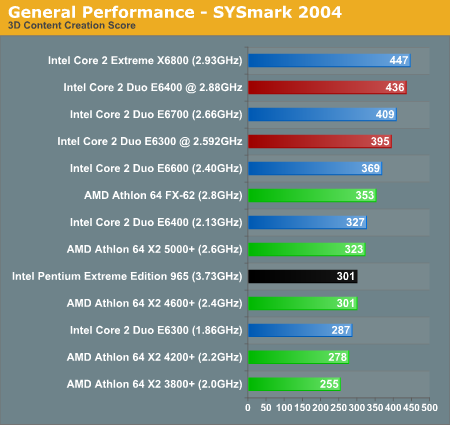
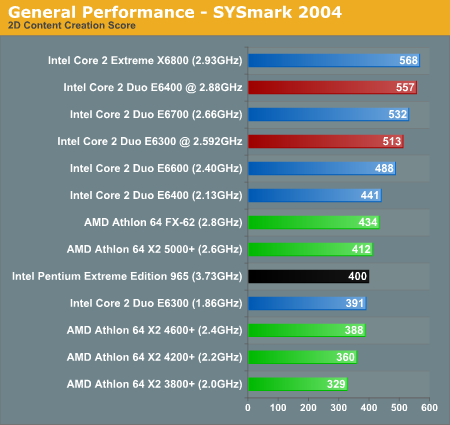

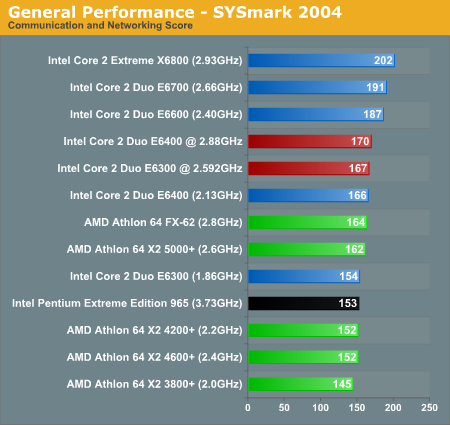
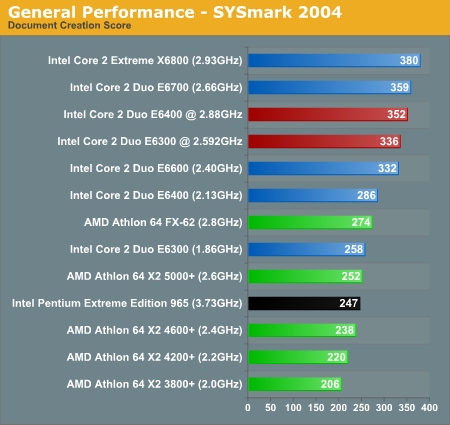
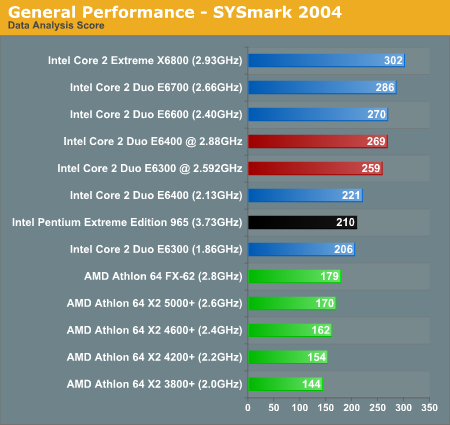










137 Comments
View All Comments
bob661 - Wednesday, July 26, 2006 - link
Give me a break dude the Intel fanbois were doing the same thing. Nothing to see here. Move along.araczynski - Wednesday, July 26, 2006 - link
looks like i'll be gettig the E6600 for great base performance with capability to overclock decently. I'll probably be sticking with a P965 mobo since i won't be going for crazy overclocking or crazy cooling solutions (that turniq cooler looks just about right for my tastes).now i just have to figure out whether to get a 7900gt/gtx/50gtx.... to last me until the second generation of the dx10's comes out...
drebo - Wednesday, July 26, 2006 - link
The pricing in this article is inaccurate. The Conroes are too low and the Athlon64s are too high.Seems to me you're using vendor pricing for one and suggested retail for the other.
coldpower27 - Wednesday, July 26, 2006 - link
No the pricing is completely accurate they are using AMD's price lists that come directly from AMD itself, and they are using Intel's prices for 1000 Unit Quantities, that will also be published on their website.If your talking about actualy price on online retailors that will remain to be seen.
drebo - Wednesday, July 26, 2006 - link
No, I'm not talking about online retailers.I'm talking about actual prices that I can get right now from my distributors and the listed suggested retail prices.
Where, exactly, are you getting your prices?
coldpower27 - Wednesday, July 26, 2006 - link
Go to AMD.com and you can get their official pricing, the listed numbers are what will be on Intel's website when they get updated for Core 2 Duo.OEM Distributer pricing is a different metric.
drebo - Wednesday, July 26, 2006 - link
Distributor pricing is what determines street and retail pricing.Intel can post the MSRP of $999 all they want, but if distributors are selling their products for more than that, the price will never be seen.
What matters is that these prices are not accurate, and paint an entirely different story than should be painted.
goinginstyle - Wednesday, July 26, 2006 - link
Neither are the AM2 prices currently as most places are selling the FX62 well above the $799. So what was your point? It is all about supply and demand, the same thing happened when AMD launched S939, the prices were way over the stated numbers by AMD. You have to start with a base, the published pricing is the base.
drebo - Thursday, July 27, 2006 - link
Genius, $799 is not MSRP for the FX-62. $799 is the price at which AMD sells the processor to its distributors. The distributor then sells the processor to retail and/or wholesale outlets with a markup. The retailers and wholesalers then sell the same product with yet another markup. Currently, my price for an FX-62 is $811. MSRP is near to $1000, but then I, and many other sellers, do not use MSRP. I use cost-based pricing.
I'm not trying to prove anything here other than that the prices listed in this article are incorrect, and that the conclusions drawn are vastly different than conclusions that could be drawn were the pricings correct.
By the way, all prices I've quoted have been for PIBs, not tray processors. I don't use OEM processors...too much liability.
coldpower27 - Thursday, July 27, 2006 - link
And, that's the thing the prices quoted are correct.
Using distributer pricing isn't a good idea as it could vary between the companies, depending on the deal you got as well, those particular prices can't be verified.
The prices listed on this chart can be since they are listed on AMD site and will be on Intel's.
There isn't a choice, unless you wish to use the real world pricing floating around as that is what matters at the end of the day, but there are issues with that, as that fluctuates.